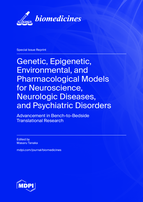Genetic, Epigenetic, Environmental, and Pharmacological Models for Neuroscience, Neurologic Diseases, and Psychiatric Disorders: Advancement in Bench-to-Bedside Translational Research
A special issue of Biomedicines (ISSN 2227-9059). This special issue belongs to the section "Neurobiology and Clinical Neuroscience".
Deadline for manuscript submissions: closed (31 May 2023) | Viewed by 29423
Special Issue Editor
Interests: neurohormones; neuropeptides; tryptophan; kynurenine; psychiatry; neurology; depression; anxiety; dementia; pain; Alzheimer’s disease; cognition; antidepressant; translational research
Special Issues, Collections and Topics in MDPI journals
Special Issue Information
Dear Colleagues,
Since the establishment of the use of animals for medical research in the mid-19th century by Claude Bernard, animal research has become an essential arena of neuroscience and experimental medicine for neurological diseases and psychiatric disorders. Currently, rodents, Caenorhabditis elegans, Drosophila melanogaster, and zebra fish are major players in the laboratory, but a growing number of other organisms are witnessed to be superior as research tools in neurosciences and behavioral sciences, such as rotifers, honeybees, locusts, sea slugs, squids, cuttlefish, turtle, and bats, among others. Developing animal models of human illnesses is a sine qua non, but a challenging task for translational research.
Genetic diseases are caused by genetic defects such as single-gene disorders, multifactorial genetic inheritance, and chromosomal abnormalities. Genetic engineering opened a promising door to generate a number of transgenic strains mimicking pathology, behaviors, and disease progression similar to a certain condition such as three mutations associated with familial Alzheimer's disease (AD) as in the triple transgenic (3xTg-AD) mouse model. Epigenetic models allow us to study the changes in chromatin status and gene expression, such as DNA methylation and histone modifications, leading to the alterations of biological functions within the organism and subsequent changes in health and behavior. Environmental models simulate the pathological and/or behavioral changes after exposure to environmental stress such as the chronic mild stress model and chronic social defeat stress of depression and anxiety. Pharmacological models reproduce the pathological and/or behavioral pictures by the administration of chemicals, such as the cuprizone-induced demyelination of multiple sclerosis and prenatal sodium valproate exposure of autism. Furthermore, inflammatory agents or inflammatory soup are applied in the autoimmune encephalitis model of multiple sclerosis or neurogenic inflammation model of migraine.
This Special Issue highlights the most recent advances in bench-to-bed translational research in the fields of neuroscience, neurology, psychiatry, and/or psychology.
We cordially invite authors to contribute original articles of laboratory or experimental medicine marking the significance of the manuscript in the last decade, review articles discussing the advancement of the specific area, and review articles forecasting possible advances in the next decade focusing on, but not limited to, the following:
- Alzheimer’s disease;
- Parkinson’s disease;
- Multiple sclerosis;
- Huntington’s disease;
- Stroke;
- Depressive disorder;
- Bipolar disorder;
- Post-traumatic stress disorder;
- Anxiety disorder;
- Social defeat;
- Schizophrenia;
- Somatic symptom disorder;
- Autism spectrum disorder;
- Hyperactive attention deficit disorder;
- Chronic pain;
- Migraine;
- Antidepressants;
- Anxiolytics;
- Analgesics;
- Antimigraine agents;
- Nootropic agents.
Dr. Masaru Tanaka
Guest Editor
Manuscript Submission Information
Manuscripts should be submitted online at www.mdpi.com by registering and logging in to this website. Once you are registered, click here to go to the submission form. Manuscripts can be submitted until the deadline. All submissions that pass pre-check are peer-reviewed. Accepted papers will be published continuously in the journal (as soon as accepted) and will be listed together on the special issue website. Research articles, review articles as well as short communications are invited. For planned papers, a title and short abstract (about 100 words) can be sent to the Editorial Office for announcement on this website.
Submitted manuscripts should not have been published previously, nor be under consideration for publication elsewhere (except conference proceedings papers). All manuscripts are thoroughly refereed through a single-blind peer-review process. A guide for authors and other relevant information for submission of manuscripts is available on the Instructions for Authors page. Biomedicines is an international peer-reviewed open access monthly journal published by MDPI.
Please visit the Instructions for Authors page before submitting a manuscript. The Article Processing Charge (APC) for publication in this open access journal is 2600 CHF (Swiss Francs). Submitted papers should be well formatted and use good English. Authors may use MDPI's English editing service prior to publication or during author revisions.







